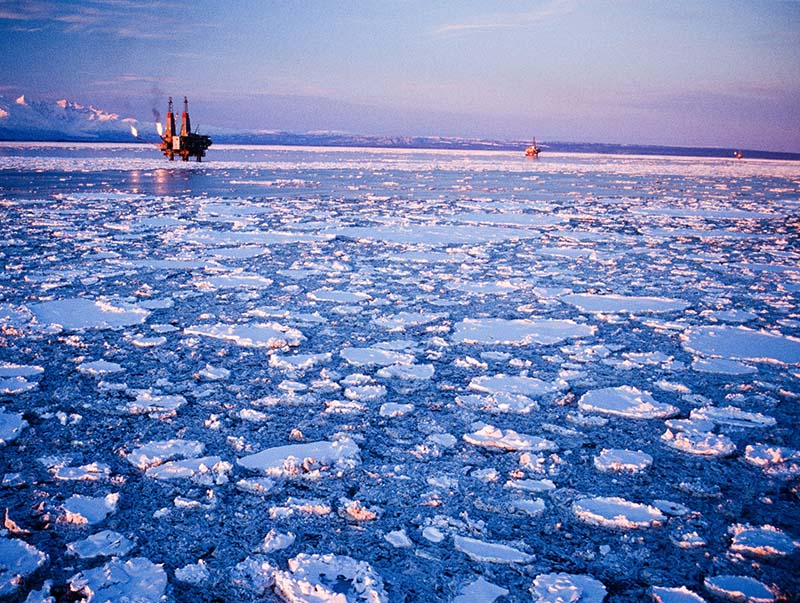(Bloomberg) — Four decades after unlocking America’s biggest oilfield, Alaska and its drillers are drifting apart.
Facing a $3.5 billion budget gap, state lawmakers narrowly voted in June to trim tax subsidies that have saved oil and gas explorers almost $1 billion a year since 2007. Governor Bill Walker followed that by freezing $430 million in rebates, and proposing more stringent cutbacks that could be approved as early as next year.
State officials say they have little choice, given the drop in oil prices and a flagging state economy. Drillers on the North Slope, the vast Arctic expanse that once led U.S. oil production and still generates a half-million barrels a day, say the policies threaten a nascent turnaround for the industry. A 6-billion barrel discovery announced this week is a sign the current system is working, they say.
“Other states and countries are looking at how we incentivize companies to keep investing," said Kara Moriarty, president of the Alaska Oil and Gas Association, an industry group in Anchorage. “Alaska is looking at just the opposite."
When oil topped $100 a barrel in 2014, Alaska took in $7.4 billion in petroleum taxes and royalties for the fiscal year that ended that June, covering almost 90% of its budget. For fiscal 2017, the take is projected at $1 billion, an 86% drop, as prices remain locked in at less than half their peak.
The tax breaks “were designed to get new production and they got that, but at a huge price," said Douglas Reynolds, an economist at the University of Alaska at Fairbanks. “Many people feel we got some bang for the buck, but it was probably less value than we gave away."
Oil companies say it’s no time to raise taxes. The North Slope’s big three producers, BP Plc, ConocoPhillips and Exxon Mobil Corp., slashed spending and cut more than 500 jobs over the past year, as the global downdraft in prices has made Alaska’s expensive crude particularly unappealing.
West Texas Intermediate, which closed above $50 a barrel for the first time since June on Thursday, fell 5 cents to $50.39 on the New York Mercantile Exchange at 12:28 p.m. in Singapore on Friday.
At the heart of the debate is a system that allows companies to deduct operating losses from their taxes. Drillers with no tax bill to offset can claim cash payments from the state. Ending or limiting that option would fall especially hard on smaller drillers who are the most likely to risk exploring for new reserves, said Randy Hoffbeck, the state’s revenue commissioner. Still, Hoffbeck said, Alaska may have no choice.
‘Taking Us Backward’
“If some of those smaller companies leave, it’s taking us backward from where we want to go, but it may be inevitable," he said.
It’s a long way from the heyday of the late 1970s, when officials cleared the way for the 800-mile (1,300-kilometer) Trans-Alaska Pipeline after the OPEC oil shocks. Tapping the inaccessible North Slope, a 95,000-square-mile region where Arctic winds roar and temperatures can fall to 60-below Fahrenheit, was seen as a symbol of oil industry ingenuity, if also the environmental risks it entailed.
North Slope production peaked at about 2 million barrels a day in 1988. It’s declined since, as companies focused exploration on cheaper opportunities elsewhere. The area produced 422,000 barrels a day in July, according to U.S. Energy Department figures.
Revival Signs
Still, there are signs of a revival. In the past year, Exxon and Conoco both began pumping from new North Slope projects. On Oct, 4, closely held Caelus Energy LLC said it had discovered an additional 6 billion barrels of oil that could double the state’s recoverable reserves.
“Without the state tax credit programs, none of this would’ve happened, and I’m not sure Caelus would’ve come to explore in Alaska," Jim Musselman, the Dallas-based company’s chief executive officer, said in a statement. “We’re proof that the credit programs work."
Exxon, Conoco and BP said they aren’t eligible for credits at current oil prices. Nonetheless, they’ve joined the chorus arguing against new taxes.
“Raising taxes on oil and gas companies in Alaska is not the way to advance the state’s economy," Aaron Stryk, an Exxon spokesman, said via e-mail. “Higher taxes undermine the efforts of companies continuing to invest in the state and those committed to future investments."
The tax breaks have encouraged exploration, agreed Hoffbeck, the revenue commissioner. But they’re untenable given Alaska’s fiscal crisis, he said by telephone.
Deficits Ahead
“The subsidies were available during a time when the state had high revenues and we were able to use them as an investment in the future," Hoffbeck said. “Now we’re in a position where we’ve lost 82% of revenues due to low oil prices and we simply cannot afford to pay subsidies."
With little rebound in sight for crude prices, Alaska faces more deficits ahead, Moody’s Investors Service said in a Sept. 14 report. The state has slashed spending by a third since 2013 and is burning through a $10 billion rainy-day fund. Nonetheless, Moody’s cut Alaska’s credit rating one notch in July, to Aa2, citing the state’s “inability to meaningfully address these severe shortfalls."
Walker, a Republican-turned-independent, has proposed a state income tax, as well as cuts to the yearly dividend checks state residents receive from investments tied to oil revenue. Both ideas face opposition in the legislature.
Hoffbeck said Alaska can’t simply wait for oil prices to recover. The state expects global crude prices to hover between $40 and $60 a barrel for years, well below the $103 needed to balance the budget, he said. Diminished output from the North Slope only makes the math harder.
“There’s no easy decision," Hoffbeck said. “If there was one, we would have landed on it already."
Bloomberg News by Alex Nussbaum





